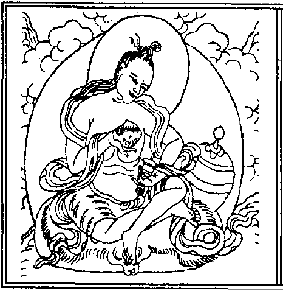Naropa
Naropa (nA ro pa) (956-1050) or (1012-1100)
According to various sources like the lineage histories of the Karma Kagyu, Drukpa Kagyu or Drikung Kagyu, Naropa was born around the year 956 and passed away around 1050. Other sources record him as having lived between the years 1012 and 1100. (Bearing in mind that his main Tibetan student Marpa was born either in 1002 or 1012, 956 is rather more likely as Naropa's year of birth.)
Naropa was born in one of the many small kingdoms of Bengal. His father was a royal chieftain by name of Shantivarman and his mother was called Srimati. His yearning for a religious life was so strong that, when he was eight years old, he travelled to Kashmir, one of the main seats for Buddhist studies in ancient times, in order to study with the master Gaganakirti. It was from Gaganakirti that he received his lay ordination.
Naropa stayed in Kashmir for three years, studying Buddhist teachings and philosophies from many great masters. By the end of his stay there he was a highly learned scholar and, upon his return to his home country, already a number of students followed him as their master.
Some years after Naropa's return from Kashmir, his parents insisted that he marry a Brahmin girl, Vimaladipi, who later on became reknowned far and wide as the female Mahasiddha Niguma. Although they were happily married, both Naropa and Niguma longed strongly for a spiritual life of studies and practice. After eight years of marriage, they decided to both take ordination. Later, Niguma became one of Naropa's most advanced disciples and a devoted spiritual companion; she served Naropa while he lived in his monastery of Pullahari.
After having thus ended their marriage, Naropa went to the hermitage of Anandarama, where he took novice ordination from the abbot Buddhasarana and the guru Jnanaprabha. He stayed with Jnanaprabha for three years, studying and mastering various philosophical treatises. He then went to Pullahari and stayed there for six years. While there, he composed several commentaries on the Guhyasamaja-tantra, Abhidharma-uttaratantra, Samvara-udbhava and Hevajra-tantra and commmented upon many other buddhist works. It was in Pullahari where later on Naropa's Tibetan disciple Marpa received many empowerments and instructions from him.
After his prolonged stay in Pullahari, Naropa went to Nalanda University, where his wisdom, skills in debate and teaching, as well as his deep spiritual understanding earned him the chancellorship of the university. He also became the "Keeper of the Northern Gate". Throughout his eight year tenure at Nalanda he was constantly engaged in difficult debates with the Tirthikas, but remained victorious each and every time. At this time, he was known as Mahapandita Abhaya Kirti.
Naropa was mostly engaged in intellectual activities until an old and ugly woman, who in fact was an emanation of Vajra Yogini, appeared before him and made him realize that all his intellectual knowledge had not brought him a single step closer to spiritual realisation. She told him to look for "her brother", his destined guru Tilopa, if he wished to attain true realisation and ultimate liberation. After this encounter, Naropa left Nalanda, searching far and wide for Tilopa, the master who would eventually lead him to the full realisation of Mahamudra.
Travelling towards the east, Naropa finally met his root guru Tilopa, who initially ignored him completely. Naropa was then put through twelve major and twelve lesser trials in order to purify his negative karma and emotional defilements and obscurations. Through the blessings from Tilopa and bringing about his own purification, Naropa realised the clarity and emptiness of mind-nature, and achieved the unified state of Vajradhara. After attaining this magnificent realisation, Naropa taught in many places and had numerous disciples, particularly in Kashmir and Zanskar where he established many monasteries.
Altogether, Naropa spent twelve years serving his guru Tilopa until the latter passed away. Naropa himself is believed to have lived until 1050 or 1100 (according to the different sources) and then attained the so-called rainbow body of great transformation, leaving no physical remains behind. Tilopa and Naropa are both counted among the Eighty-four Mahasiddhas of India.
Amongst Naropa's accomplished disciples was Marpa the translator, who became one of his lineage-holders. He brought Naropa's teachings to Tibet, translated and spread them ther, and became thus the founder of the Kagyu lineages.
Please expand this page by pressing EDIT above.
Literary Works[edit]
Main Teachers[edit]
Main Students[edit]
Main Lineages[edit]
Alternate Names[edit]
Other Reference Sources[edit]
Internal Links[edit]
External Links[edit]
- Listings of Works by Naropa at TBRC
